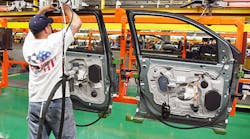U.S. manufacturing and services firms expect to see rising revenues and profits next year, amid a stronger economy and only modest increases in costs, according to the Institute of Supply Management.
The ISM semi-annual economic forecast also showed that companies expect a small increase in employment across both sectors, after a contraction in 2016.
“On the whole we’re looking at a positive year,” said Bradley Holcomb, chair of the ISM Manufacturing Business Survey Committee, which releases a monthly survey of industry purchasing managers.
Manufacturers are expecting revenues to accelerate 4.6% next year, after a meager increase of less than 1% this year. Meanwhile, labor and benefits costs and prices of inputs are expected to rise only modestly in 2017, 2.5% and 1.3%, respectively.
“These two represent the lion’s share of the cost of manufacturing” so with the expected jump in revenue it means “profit margins will open up and make our companies even healthier as we go forward,” Holcomb told AFP.
Revenues for non-manufacturing companies are expected to jump a similar amount, 4.1%.
Hiring is a small bright spot in the forecast as both sectors expect to increase employment after declines this year, but the gains are fairly small: barely 0.5% for manufacturing and just over 1% for non-manufacturing companies. Both sectors are starting to see some reports of trouble finding skilled employees to fill openings, which could put pressure on labor costs in the coming year.
“Finding the skilled labor force has been tight for many of the non-manufacturing companies,” Anthony Nieves, chair of the ISM Non-Manufacturing Business Survey Committee, told AFP. “Skilled labor has been a commodity listed not only in short supply, but also rising in cost.”
Reports of a tight labor market are something that will make the Federal Reserve sit up and take notice. Although U.S. unemployment in November dropped to a nine-year low of 4.6%, wage increases so far have been contained. But the central bank is expected to hike the key interest rate next week for the first time in a year, given concerns about the potential for inflation.
The ISM survey shows firms expect only a modest increase in capital expenditure next year, which could be a pause from the big jump in investment in 2016, or may just reflect a cautious attitude that will adjust later in the year, Holcomb said.
Manufacturing executives expect only a 0.2% increase in expenditures, after the 7.3% jump for this year, while non-manufacturing managers see a decline of 0.2% after the 10.6% surge in 2016.
Holcomb said it was not unusual to have a “low prediction going into the year, and actually increase as the year progresses.”
One surprising element of the forecast is that 64% of executives surveyed said the strong U.S. dollar had a negligible or positive impact on the firm’s profits. That is especially surprising for manufacturing firms, which are generally thought to oppose a strong currency since that makes their exports more expensive to overseas customers.
But Holcomb explained that the strong dollar reduces the cost of raw materials and inputs which amount to more than exports in many cases.
Copyright Agence France-Presse, 2016




